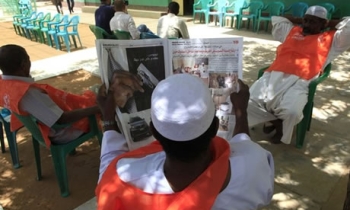The concept of the free commuter newspaper which dawned at the turn of the millennium is alive and well — and growing worldwide. Yet the concept has grown beyond its original point of distribution, beyond its original business model, and even beyond its content model, says a new report by the International Newspaper Marketing Association (INMA).
The INMA report, Free and 'Lite' Newspapers: The Answer For the New Generation? explores how slimmed-down print products are being used to turn young urban professionals into the newspaper readers of tomorrow. It takes a closer look at how product strategies are being used to draw in new readers and reach untouched audiences. It does so by exploring the two broad genres of product that publishers have injected into urban markets: stand-alone dailies and brand extension "lite" newspapers.

The report, authored by James Khattak, says, "The new free/lite daily newspapers have emerged in the past decade as established players in the modern newspaper market. They are holding their own in competition with traditional newspapers, and a growing number of publishers are turning to them to shore up deficiencies in reaching the upmarket young adult that heavier, advertising-rich, high-margin paid newspapers have failed to reach. Newspapers are especially facing growing pressures in mature markets flooded with news and information sources.
"For example, the Internet has become a viable news source for many. Advertisers, meanwhile, have new tools available to them that allow better analysis of the positioning of their marketing options and the targeting of their messages. Other tools are allowing the man or woman on the street to generate their own news content and reach a global audience."
Small, easily portable free and low-cost commuter newspapers target a segment of the population that traditional newspaper publishers have long tried to reach: non- or irregular readers. Their success in reaching this audience and drawing readers from traditional newspapers, have allowed free urban commuter newspapers to move from marginal to mainstream players in a number of countries, the report says.
The continued encroachment of free newspapers into traditional paid newspapers’ markets, acording to the INMA report, represents an “opportunity lost” for these publishers in their mission to convert non-readers and free readers into paid readers. Although a recent Metro launch in Lisbon may not have immediately taken readers away from Portuguese newspapers, the established 11-year presence of Metro in Stockholm has conditioned a segment of the market to expect their news for free and to look to Metro for it. This is an advantage that will likely never be gained by traditional publishers.

The report cites the example of Spain, which has some 20-odd free newspapers with a combined circulation of almost 3.5 million. Free newspapers represented 15 per cent of Spain’s daily newspaper distribution in 2001. They captured 38 per cent of the market in 2005. This growth has more than offset the drop in paid circulation since 2001. Despite traditional newspaper circulation dropping 1 per cent over the past four years, the emergence of free newspapers in the market has left Spain with 700,000 more daily newspapers distributed each day.
The “lite” newspaper, the report points out, relies heavily on the resources off which the slimmed-down product is spun. These products repackage the brand, content, and in many cases, the advertising of the parent newspaper to reach new audiences. Spreading the newspapers’ production costs across multiple titles makes this type of product an accessible option for publishers. However, the report cautions, "The close associations in image and content between the parent and brand extension newspapers and the lite newspapers’ lower cover prices, can erode the circulation of the more expensive core product. Whether the brand extension newspaper proves successful enough to offset those losses is the gamble their publishers make.
The report documents more than 20 case studies of newspaper publishers using free commuter dailies and brand-extension "lite" newspapers to reach audiences with innovative, appealing new print products: like the Metro, which began in Stockholm’s public transportation system, and continues to use local commuter systems as a primary part of its distribution; 20 Minutes, a reader-focused product, politically neutral with a strong distribution level and clear target group.
Advertisers are growing increasingly comfortable with free/lite newspapers. "They see product genres as entrées into new demographic segments that do not typically read paid quality newspapers. Free/lite newspapers can target audiences to a degree unavailable to the more generalist traditional dailies. In fact, free/lite newspapers have been seen to draw advertisers that do not typically utilise newspapers – owing to their ability to reach new audiences," the report points out.

Distribution of free/lite newspapers is no longer exclusively tied to public transportation systems. When INMA last examined this subject in 2002, executives at Metro and 20 Minutes told the association that the concept would extend beyond the mas-transit markets. "Today, that change is upon us," the report says. While train and bus stations are still primary factors of free/lite newspapers’ circulation and in some markets always will be, publishers are roving farther afield in their drive to be where their readers are. Free/lite newspaper news racks and boxes are appearing at universities, hospitals, restaurants, and retail locations.
A number of free/lite newspapers are also offering home delivery, finding advantages in taking the final step to readers’ front doors. The Examiner titles in the United States use home delivery to target the affluent neighbourhoods in their markets and reach audiences highly desirable to their advertisers. Also in the United States, the Spanish-language Al Día uses home delivery to reach customers who live outside the primarily Hispanic areas in which the company focuses its street-side distribution.
The report concludes, "Looking ahead, free and lite newspapers seem set to continue growing as a force within the newspaper industry. New projects are in the works, and expansion is seen in the short-term from the established titles. While the low-cost model has not been dropped completely, free distribution seems to be the method of choice for a growing number of publishers. As they move toward becoming the establishment, the terms 'free newspaper' or 'lite newspaper' themselves may fall out of fashion — if they haven’t already."









